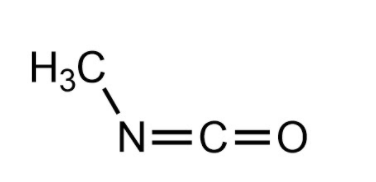
Answer
453.9k+ views
Hint: The gas leaked from a storage tank of the Union Carbide plant in Bhopal gas tragedy was methyl isocyanate (\[C{H_3}NCO\]).
Complete answer:
Methyl isocyanate (MIC) is an organic compound with the molecular formula \[C{H_3}NCO\] and it is very toxic.

Methyl isocyanate is a poisonous, lachrymatory (tearing agent), colorless, flammable liquid with a sharp pungent odor and It is soluble in water.
Methyl isocyanate is usually prepared by the reaction of mono methylamine with phosgene at high temperatures. For production on a large scale, it is advantageous to combine these reactants at higher temperatures in the gas phase. By this mixture, one mole of methyl isocyanate and two moles of hydrogen chloride is formed.
The toxic effect of this compound appeared in the 1984 Bhopal disaster when around 42,000 kilograms of methyl isocyanate and other gases were released from the underground reservoirs of the Union Carbide India Limited (UCIL) factory. This incident happened on December 3, 1984. This chemical killed about 3,500 people immediately and 15,000 more over the next several years.
Hence, the answer is an option (d) i.e. methyl isocyanate.
Note:
Remember that the gas was methyl isocyanate, not methyl cyanide. Methyl cyanide doesn’t show instant toxic effects. Methyl isocyanate exposure can cause pulmonary edema, bronchospasm, or an electrolyte imbalance in the human body.
Complete answer:
Methyl isocyanate (MIC) is an organic compound with the molecular formula \[C{H_3}NCO\] and it is very toxic.

Methyl isocyanate is a poisonous, lachrymatory (tearing agent), colorless, flammable liquid with a sharp pungent odor and It is soluble in water.
Methyl isocyanate is usually prepared by the reaction of mono methylamine with phosgene at high temperatures. For production on a large scale, it is advantageous to combine these reactants at higher temperatures in the gas phase. By this mixture, one mole of methyl isocyanate and two moles of hydrogen chloride is formed.
The toxic effect of this compound appeared in the 1984 Bhopal disaster when around 42,000 kilograms of methyl isocyanate and other gases were released from the underground reservoirs of the Union Carbide India Limited (UCIL) factory. This incident happened on December 3, 1984. This chemical killed about 3,500 people immediately and 15,000 more over the next several years.
Hence, the answer is an option (d) i.e. methyl isocyanate.
Note:
Remember that the gas was methyl isocyanate, not methyl cyanide. Methyl cyanide doesn’t show instant toxic effects. Methyl isocyanate exposure can cause pulmonary edema, bronchospasm, or an electrolyte imbalance in the human body.
Recently Updated Pages
10 Examples of Evaporation in Daily Life with Explanations

10 Examples of Diffusion in Everyday Life

1 g of dry green algae absorb 47 times 10 3 moles of class 11 chemistry CBSE

What happens when dilute hydrochloric acid is added class 10 chemistry JEE_Main

What is the meaning of celestial class 10 social science CBSE

What causes groundwater depletion How can it be re class 10 chemistry CBSE

Trending doubts
Fill the blanks with the suitable prepositions 1 The class 9 english CBSE

Which are the Top 10 Largest Countries of the World?

How do you graph the function fx 4x class 9 maths CBSE

Who was the leader of the Bolshevik Party A Leon Trotsky class 9 social science CBSE

The Equation xxx + 2 is Satisfied when x is Equal to Class 10 Maths

Differentiate between homogeneous and heterogeneous class 12 chemistry CBSE

Difference between Prokaryotic cell and Eukaryotic class 11 biology CBSE

Which is the largest saltwater lake in India A Chilika class 8 social science CBSE

Ghatikas during the period of Satavahanas were aHospitals class 6 social science CBSE




